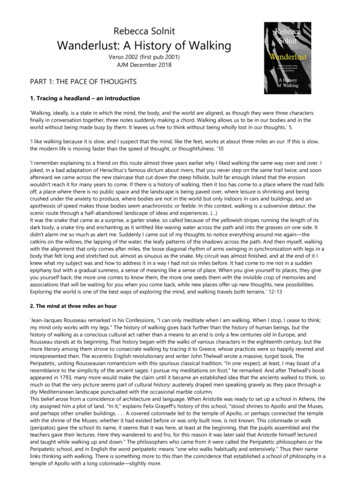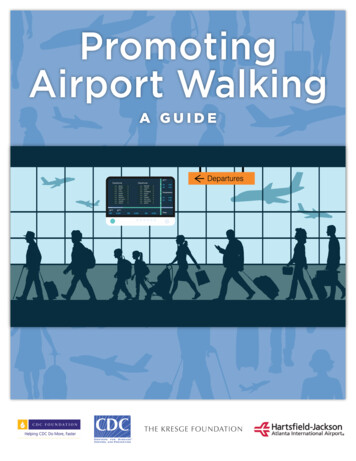
Transcription
Rebecca SolnitWanderlust: A History of WalkingVerso 2002 (first pub 2001)AJM December 2018PART 1: THE PACE OF THOUGHTS1. Tracing a headland – an introduction‘Walking, ideally, is a state in which the mind, the body, and the world are aligned, as though they were three charactersfinally in conversation together, three notes suddenly making a chord. Walking allows us to be in our bodies and in theworld without being made busy by them. It leaves us free to think without being wholly lost in our thoughts.’ 5.‘I like walking because it is slow, and I suspect that the mind, like the feet, works at about three miles an our. If this is slow,the modern life is moving faster than the speed of thought, or thoughtfulness. ‘10‘I remember explaining to a friend on this route almost three years earlier why I liked walking the same way over and over. Ijoked, in a bad adaptation of Heraclitus's famous dictum about rivers, that you never step on the same trail twice; and soonafterward we came across the new staircase that cut down the steep hillside, built far enough inland that the erosionwouldn't reach it for many years to come. If there is a history of walking, then it too has come to a place where the road fallsoff, a place where there is no public space and the landscape is being paved over, where leisure is shrinking and beingcrushed under the anxiety to produce, where bodies are not in the world but only indoors in cars and buildings, and anapotheosis of speed makes those bodies seem anachronistic or feeble. In this context, walking is a subversive detour, thescenic route through a half-abandoned landscape of ideas and experiences. (.)It was the snake that came as a surprise, a garter snake, so called because of the yellowish stripes running the length of itsdark body, a snake tiny and enchanting as it writhed like waving water across the path and into the grasses on one side. Itdidn't alarm me so much as alert me. Suddenly I came out of my thoughts to notice everything around me again—thecatkins on the willows, the lapping of the water, the leafy patterns of the shadows across the path. And then myself, walkingwith the alignment that only comes after miles, the loose diagonal rhythm of arms swinging in synchronization with legs in abody that felt long and stretched out, almost as sinuous as the snake. My circuit was almost finished, and at the end of it Iknew what my subject was and how to address it in a way I had not six miles before. It had come to me not in a suddenepiphany but with a gradual sureness, a sense of meaning like a sense of place. When you give yourself to places, they giveyou yourself back; the more one comes to know them, the more one seeds them with the invisible crop of memories andassociations that will be waiting for you when you come back, while new places offer up new thoughts, new possibilities.Exploring the world is one of the best ways of exploring the mind, and walking travels both terrains.’ 12-132. The mind at three miles an hour‘Jean-Jacques Rousseau remarked in his Confessions, "I can only meditate when I am walking. When I stop, I cease to think;my mind only works with my legs." The history of walking goes back further than the history of human beings, but thehistory of walking as a conscious cultural act rather than a means to an end is only a few centuries old in Europe, andRousseau stands at its beginning. That history began with the walks of various characters in the eighteenth century, but themore literary among them strove to consecrate walking by tracing it to Greece, whose practices were so happily revered andmisrepresented then. The eccentric English revolutionary and writer John Thelwall wrote a massive, turgid book, ThePeripatetic, uniting Rousseauian romanticism with this spurious classical tradition. "In one respect, at least, I may boast of aresemblance to the simplicity of the ancient sages: I pursue my meditations on foot," he remarked. And after Thelwall's bookappeared in 1793, many more would make the claim until it became an established idea that the ancients walked to think, somuch so that the very picture seems part of cultural history: austerely draped men speaking gravely as they pace through adry Mediterranean landscape punctuated with the occasional marble column.This belief arose from a coincidence of architecture and language. When Aristotle was ready to set up a school in Athens, thecity assigned him a plot of land. "In it," explains Felix Grayeff's history of this school, "stood shrines to Apollo and the Muses,and perhaps other smaller buildings. . . . A covered colonnade led to the temple of Apollo, or perhaps connected the templewith the shrine of the Muses; whether it had existed before or was only built now, is not known. This colonnade or walk(peripatos) gave the school its name, it seems that it was here, at least at the beginning, that the pupils assembled and theteachers gave their lectures. Here they wandered to and fro, for this reason it was later said that Aristotle himself lecturedand taught while walking up and down." The philosophers who came from it were called the Peripatetic philosophers or thePeripatetic school, and in English the word peripatetic means "one who walks habitually and extensively." Thus their namelinks thinking with walking. There is something more to this than the coincidence that established a school of philosophy in atemple of Apollo with a long colonnade—slightly more.
The Sophists, the philosophers who dominated Athenian life before Socrates, Plato, and Aristotle, were famously wandererswho often taught in the grove where Aristotle's school would be located. Plato's assault on the Sophists was so furious thatthe words sophist and sophistry are still synonymous with deception and guile, though the root sophia has to do withwisdom. The Sophists, however, functioned something like the chautauquas and public lecturers in nineteenth-centuryAmerica, who went from place to place delivering talks to audiences hungry for information and ideas. Though they taughtrhetoric as a tool of political power, and the ability to persuade and argue was crucial to Greek democracy, the Sophiststaught other things besides. Plato, whose half-fabricated character Socrates is one of the wiliest and most persuasivedebaters of all times, is somewhat disingenuous when he attacks the Sophists.Whether or not the Sophists were virtuous, they were often mobile, as are many of those whose first loyalty is to ideas.’ 1415‘Rousseau . claimed, “Never did I think so much, exist so vividly, and experience so much, never have I been so much myself. as in the journeys I have taken alone and on foot. There is something about walking which stimulates and enlivens mythoughts. When I stay in one place I can hardly think at all; my body has to be on the move to set my mind going. The sightof the countryside, the succession of pleasant views, the open air, a sound appetite, and the good health I gain by walking,the waspy atmosphere of an inn, the absence of everything that makes me feel my dependence, of everything that recallsme to my situation – all these serve to free my spirit, to lend a greater boldness to my thinking, so that I can combine them,select them, and make them mine as I will, without fear or restraint. “ 19‘At the end of his life, he wrote Reveries of a Solitary Walker (Les Reveries du promeneur solitaire in the original; 1782), ), abook that is and is not about walking. Each of its chapters is called a walk, and in the Second Walk, he states his premise:"Having therefore decided to describe my habitual state of mind in this, the strangest situation which any mortal will everknow, I could think of no simpler or surer way of carrying out my plan than to keep a faithful record of my solitary walks andthe reveries that occupy them." Each of these short personal essays resembles the sequence of thoughts or preoccupationsone might entertain on a walk, though there is no evidence they are the fruit of specific walks. Several are meditations on aphrase, some are recollections, some are little more than aired grievances. Together the ten essays (the eighth and ninthwere still drafts and the tenth was left unfinished at the time of his death in 1778) portray a man who has taken refuge in thethoughts and botanical pursuits of his walks, and who through them seeks and recalls a safer haven.’ 20-21‘The literature of philosophical walking begins with Rousseau.’ 223. Rising and Falling: the Theorists of Bipedalism‘Nowadays walking upright is considered to be the Rubicon the evolving species crossed to become hominid, distinct fromall other primates and ancestral to human beings.’ Lucy, austrilopithecus africanus, 3.2m years old, found in Ethiopia Lucywalked., fully upright.4. The Uphill Road to Grace: Some Pilgrimages‘Walking came from Africa, from evolution, and from necessity, and it went everywhere, usually looking for something. Thepilgrimage is one of the basic modes of walking, walking in search of something intangible.’ 45.‘Pilgrimage is almost universally embedded in human culture as a literal means of spiritual journey, and asceticism andphysical exertion are almost universally understood as a means of spiritual development. ‘ 46.‘Pilgrimage is premised on the idea that the sacred is not entirely immaterial, but that there is a geography of spiritualpower. Pilgrimage walks a delicate line between the spiritual and the material in its emphasis on the story and its setting:though the search is for spirituality, it is pursued in terms of the most material details—of where the Buddha was born orwhere Christ died, where the relics are or the holy water flows. Or perhaps it reconciles the spiritual and the material, for togo on pilgrimage is to make the body and its actions express the desires and beliefs of the soul. Pilgrimage unites belief withaction, thinking with doing, and it makes sense that this harmony is achieved when the sacred has material presence andlocation. Protestants, as well as the occasional Buddhist and Jew, have objected to pilgrimages as a kind of icon worship andasserted that the spiritual should be sought within as something wholly immaterial, rather than Out in the world.There is a symbiosis between journey and arrival in Christian pilgrimage, as there is in mountaineering. To travel withoutarriving would be as incomplete as to arrive without having traveled. To walk there is to earn it, through laboriousness andthrough the transformation that comes during a journey. Pilgrimages make it possible to move physically, through theexertions of one's body, step by step, toward those intangible spiritual goals that are otherwise so hard to grasp. We areeternally perplexed by how to move toward forgiveness or healing or truth, but we know how to walk from here to there,however arduous the journey. Too, we tend to imagine life as a journey, and going on an actual expedition takes hold of thatimage and makes it concrete, acts it out with the body and the imagination in a world whose geography has becomespiritualized. The walker toiling along a road toward some distant place is one of the most compelling and universal imagesof what it means to be human, depicting the individual as small and solitary in a large world, reliant on the strength of bodyand will. In pilgrimage, the journey is radiant with hope that arrival at the tangible destination wit bring spiritual benefits withit. The pilgrim has achieved a story of his or her own and in this way too becomes part of the religion made up of stories oftravel and transformation.’50
5. Labyrinths and Cadillacs: Walking into the Realm of the Symbolic‘The cloisters that were part of every monastery and convent sometimes bore elaborate Christian stories. Usually a squarearcade around a garden with a central well, pool, or fountain, the cloister was where monks or nuns could walk withoutleaving the contemplative space of the order. Renaissance gardens had elaborately arranged mythological and historicalstatues. Because the walker already knew the story, no words need be said.’ 74-75‘But if the book has eclipsed the memory palace as a repository of information, it has retained some of its pattern. In otherwords, if there are walks that resemble books, there are also books that resemble walks and use the “reading” activity ofwalking to describe a world. The greatest example is Dante’s Divine Comedy. Like a vast number of stories before and after,it is a travel story, one in which the movement of the narrative is echoed by the movement of the characters across animaginary landscape.’ 77-78PART TWO: FROM THE GARDEN TO THE WILD6. The path out of the garden‘Halfway through the nineteenth century, Thoreau wrote, "When we walk, we naturally go to the fields and woods: whatwould become of us, if we walked only in a garden or a mall?" For Thoreau, the desire to walk in the unaltered landscape nolonger seemed to have a history, but to be natural—if nature means the timeless truth we have found, not the historicspecific we have made. Though many nowadays go to the fields and woods to walk, the desire to do so is largely the resultof three centuries of cultivating certain beliefs, tastes, and values. Before that, the privileged seeking pleasure and aestheticexperience did indeed walk only in a garden or a mall. The taste for nature already entrenched in Thoreau's time andmagnified in our own has a peculiar history, one that has made nature itself cultural. To understand why people chose towalk out in certain landscapes with certain agendas, one must first understand how that taste was formed in and launchedfrom English gardens.We tend to consider the foundations of our culture to be natural, but every foundation had builders and an origin—which isto say that it was a creative construction, not a biological inevitability. Just as a twelfth-century cultural revolution ushered inromantic love as first a literary subject and then a way of experiencing the world, so the eighteenth century created a tastefor nature without which William and Dorothy Wordsworth would not have chosen to walk long distances in midwinter andto detour from their already arduous course to admire waterfalls. This is not to say that no one felt a tender passion oradmired a body of water before these successive revolutions, it is instead to say that a cultural framework arose that wouldinculcate such tendencies in the wider public, give them certain conventional avenues of expression, attribute to themcertain redemptive values, and alter the surrounding world to enhance those tendencies. It is impossible to overemphasizehow profound is the effect of this revolution on the taste for nature and practice of walking. It reshaped both the intellectualworld and the physical one, sending populations of travelers to hitherto obscure destinations, creating innumerable parks,preserves, trails, guides, clubs, and organizations and a vast body of art and literature with almost no precedent before theeighteenth century.’ 84-85‘The real reason Wordsworth and his peers seem to be the founders rather than the transformers of a tradition of walking foraesthetic reasons is because the walks that preceded theirs are so unremarkable. In fact these short walks in safe places areonly incidental to the histories of architecture and gardens; they have no literature of their own, only mentions in novels,journals, and letters. The core of their history is concealed within another history, of making places to walk, places thatbecame larger and more culturally significant as the eighteenth century wore on. It is also the history of a radicaltransformation of taste, from the formal and highly structured to the informal and naturalistic. It seems, in its origins, a trivialhistory of the idle aristocracy and their architecture, but in its results it created some of the most subversive and delightfulplaces and practices in the contemporary world. The taste for walking and landscape became a kind of Trojan horse thatwould eventually democratize many arenas and in the twentieth century literally bring down the barriers around aristocraticestates.The practice of walking can be traced through places. By the sixteenth century, as castles were beginning to turn into palacesand mansions, galleries—long narrow rooms like corridors, though often leading nowhere—often began to be part of thedesign. They were used for exercise indoors. "Sixteenth-century doctors stressed the importance of daily walking to preservehealth, and galleries made exercise possible when the weather would otherwise have prevented it," writes Mark Girouard inhis history of the country house. (The gallery eventually became a place for displaying paintings, and though museumgalleries are still a place where people stroll, the strolling is no longer the point.) Queen Elizabeth added a raised terrace walkto Windsor Castle and walked there for an hour before dinner on every day that was not too windy. Walking was still morefor health than for pleasure, though gardens were also being used for walking, and some kind of pleasure must have accruedthere. But the taste for landscape was still fairly limited. On October 11, 1660, Samuel Pepys went walking in St. James's Parkafter dinner, but he only notes the water pumps at work there. Two years later, on May 21, 1662, he writes that he and hiswife went walking in White Hall Garden, but he seemed most interested in the lingerie of the king's mistress in the privygarden, evidently hung there to dry. It was society that interested him, not nature, and landscape was not yet a significantsubject for British painting and poetry, as it was to become. Until the surroundings became important, the walk was justmovement, not experience.
A revolution was under way, however, in gardens. The medieval garden had been surrounded by high walls, in part forsecurity in unstable times. In pictures of these gardens, the occupants most often sit or recline, listening to music orconversing . As the world became safer and the aristocratic residence became more a palace than a fortress, the gardens ofEurope began to expand. Flowers and fruit were disappearing from the gardens; it was the eye to which these expandedrealms appealed. The Renaissance garden was a place in which one could take a walk as well as sit, and the Baroque gardengrew vast. Just as walking was exercise for those who need no longer work, so these vast gardens were cultivated landscapesthat need no longer produce anything more than mental, physical, and social stimulation for walkers.’ 86-87‘When the ha-ha came into being in the early decades of the eighteenth century, the walls came down in Britain. A ditchrelatively invisible from any distance, the ha-ha—so named because strollers were said to exclaim "Ha ha!" in surprise whenthey came upon it—provided an invisible barrier that allowed the garden's inhabitants to gaze into the distanceuninterrupted. Where the eye went, the walker would soon follow. Most English estates consisted of a series of increasinglycontrolled spaces: the park, the garden, and the house. Originally hunting preserves, parks remained as a kind of buffer zonebetween the leisure classes and the agricultural land and workers around them and often provided timber and grazingspace. The garden was typically a much smaller space surrounding the house. Susan Lasdun, in her history of these parks,writes of the straight avenues of trees planted in parks and gardens in the seventeenth century: "These avenues provided theshade and shelter for walks which, having been made fashionable by Charles II, were now becoming de rigueur in parks. . . .Certainly the liking for air and exercise was already considered an 'English' taste. Walks were now laid out by private ownersin their country parks, and walking became as much a part of the pleasure of a park as hunting, driving and riding. The walksthemselves were made increasingly interesting, with aesthetic considerations developing from the simple static vista from awindow or terrace, to something that took account of a more mobile point of view. . . . The walker in fact made a circuit, andin the eighteenth century this was to become the standard manner for viewing gardens and parks. The days when it was onlysafe to walk on the castle terrace—the allure—had long since passed."’The formal garden, with its patterns made of clipped hedges, geometric pools, and trees in orderly ranks, had suggested thatnature was a chaos on which men imposed order. In England the garden would become less and less formal as theeighteenth century progressed, and this idea of naturalistic landscaping that would be called the jardin anglais, the Englishgarden, or the landscape garden is one of the great English contributions to Western culture. As the visual barrier thatseparated it from its surroundings vanished, the design of the garden became less distinctly separate too.’ 88-89.‘Lancelot “Capability” Brown, the landscape architect who was to complete the revolution in garden design with hisunadorned expanses of water, trees, and grass. The garden, in the course of becoming more and more indistinguishablefrom the surrounding landscape, had become unnecessary – Walpole had said of the landscape architect William Kent thatthe had “leapt the fence and saw all nature was a garden.” If a garden was nothing more than a visually pleasing space inwhich to wander, then gardens could be found rather than made, and the tradition of the garden walk could expand tobecome the tourist’s excursion. Rather than looking at the work of man, the scenic stroller could look at the works of nature,and to look at nature as a work of art completed a momentous revolution. In Shaftesbury's terms, princely gardens hadfinally given way to wilderness, the nonhuman world had become a fit subject for aesthetic contemplation.The aristocratic garden had begun as part of the fortified castle, and slowly its boundaries had melted away the melting ofthe garden into the world is a mark of how much safer England had become (and to a lesser degree, much of westernEurope, where the fashion for the English garden soon caught on). Since about 1770, England had undergone a"transportation revolution" of improved roads, decreased roadside crime, and cheaper fares. The very nature of travelchanged. Before the mid-eighteenth century, travel accounts have little to say about the land between religious or culturallandmarks. Afterward, an entirely new way of travel arose. In pilgrimage and practical travel, the space between home anddestination had been an inconvenience or an ordeal. When this space became scenery, travel became an end in itself, anexpansion of the garden stroll. That is to say, the experiences along the way could replace destinations as the purpose oftravel. And if the whole landscape was the destination, one arrived as soon as one set out in this world that could be lookedat as a garden or a painting. Walking had long been recreational, but travel had joined it, and it was only a matter of timebefore traveling on foot would itself become a widespread part of the pleasures of scenic travel, its slowness finally a virtue.The point at which a poor poet and his sister might travel across a snowy countryside for the pleasure of looking andwalking was drawing near.’ 92-937. The Legs of William WordsworthThomas de Quincey calculated that Wordsworth must have walked 175-180K miles in his lifetime; he walked nearly every day,‘and walking was both how he encountered the world and how he composed his poetry’. ‘For Wordsworth walking was amode not of travelling, but of being. The turning point in both his life and The Prelude is his amazing 1790 walk with hisfellow student Robert Jones across France into the Alps, when they should have been studying for their CambridgeUniversity exams. Wordsworth’s most recent biographer, Kennedy Johnson, dramatically declares, “With this act ofdisobedience his career as a Romantic poet may be said to have begun.”’ 107‘The walkers in the garden had been anxious to distinguish their walking for pleasure form that of those who walked fornecessity, which is why it was important to stay within the garden’s bounds and not to walk as travel – but Wordsworthsought out meetings with those who represented this other kind of walking. But walking wasn’t only a subject for
Wordsworth. It was his means of composition. Most of his poems seem to have been composed while he walked and spokealoud, to a companion or to himself. In The Prelude he describes a dog he used to walk with who would, when a strangerdrew near, cue him to shut up and avoid being taken for a lunatic.’ 113‘Of all the other Romantics, only De Quincey seems to have had a lifelong passion for walking comparable to Wordsworth’s,and though it is impossible to measure pleasure, it is possible to say something about effects: walking was neither a subjector a compositional method for the younger writer in the way it had been for the older. – Morris Marples credits him withbeing the first to go on a walking tour with a tent, which he slept in during an early sojourn in Wales to save money (thebeginnings of the outdoor equipment industry show up here, in the special coats Wordsworth and Robert Jones had a tailormake them for their continental tour, in Coleridge’s walking sticks, in De Quincey’s tent, in Keats’s odd travel outfit). Hisfellow essayist William Hazlitt wrote the first essay on walking, but it began another genre of walking literature rather thanextending the tradition Wordsworth took up, and it depicts walking as a pastime rather than a vocation. Shelley was tooaristocratic an anarchist and Byron to lame an aristocrat to have had much to do with walking; they wailed and rode instead.Coleridge, on the other hand, had a decade of avid walking – 1794-1804 – which is reflected in his poetry from that time. Heand the Wordsworths walked together many more times. Although the links between walking and writing are neither soexplicit nor so profuse in his work as in his friend’s , the critic Robin Jarvis does point out that Coleridge ceased to writeblank verse when he ceased to walk.’ 116.8. A Thousand Miles of Conventional Sentiment : The Literature of Walking‘The first essay specifically on walking is William Hazlitt's 1821 "On Going a Journey," and it establishes the parameters forwalking "in nature" and for the literature of walking that would follow. "One of the pleasantest things in the world is going ajourney, but I like to go by myself," it opens. Hazlitt declares that solitude is better on a walk because "you cannot read thebook of nature, without being perpetually put to the trouble of translating it for the benefit of others" and because "1 wantto see my vague notions float like the down of the thistle and not to have them entangled in the briars and thorns ofcontroversy." Much of his essay is about the relationship between walking and thinking. But his solitude with the book ofnature is very questionable, since in the course of the short piece he manages to quote from other books by Virgil,Shakespeare, Milton, Dryden, Gray, Cowper, Sterne, Coleridge, and Wordsworth, along with the Book of Revelation. Hedescribes a day of walking thorough Wales launched by reading Rousseau’s Nouvelle Heloise the night before and quotingColeridge’s landscape poetry as he goes. Clearly, the books set forth the kind of experience of walking in nature he shouldhave – pleasant, mingling thoughts, quotations, and scenery – and Hazlitt manages to have it. If nature is a religion andwalking its principal rite, then these are its scriptures being organized into a canon.Hazlitt’s essay became the foundation of a genre.’ 120‘In 1913 the historian G. M. Trevelyan begins his "Walking" with "I have two doctors, my left leg and my right. When bodyand mind are out of gear (and those twin parts of me live at such close quarters that the one always catches the melancholyfrom the other) I know that I shall have only to call in my doctors and I shall be well again. . . . My thoughts start out with melike blood-stained mutineers debauching themselves on board the ship they have captured, but I bring them home atnightfall, larking and tumbling over each other like happy little boy scouts at play."’ 121Thoreau.John Muir.‘The most impressive of the contemporary long-distance walkers I have read. is Robyn Davidson, who didn’t exactly set outto write about walking at all, but did so brilliantly in the course of her Tracks, a book recounting her 1,700 mile trek acrossthe Australian outback to the sea with three camels. . Midway in her journey, she explains its effect on her mind: "Butstrange things do happen when you trudge twenty miles a day, day after day, month after month. Things you only becometotally conscious of in retrospect. For one thing I had remembered in minute and Technicolor detail everything that had everhappened in my past and all the people who belonged there. I had remembered every word of conversation I had had oroverheard way, way back in my childhood and in this way I had been able to review these events with a kind of emotionaldetachment as if they had happened to somebody else. I was rediscovering and getting to know people who were long sincedead and forgotten. . . . And I was happy, there is simply no other word for it." She brings us back to the territory of thephilosophers and the walking essayists, to the relationship between walking and the mind, and she does it from a kind ofextreme experience few have had.’ 1309. Mount Obscurity and Mount ArrivalAbout mountaineering.Henriette d’Angeville (first woman to climb Mont Blanc) : ‘The soul has needs, as does the body, peculiar to each individual. Iam among those who prefer the grandeur of natural landscapes to the sweetest or most charming views imaginable. andthat is why I chose M
Wanderlust: A History of Walking Verso 2002 (first pub 2001) AJM December 2018 PART 1: THE PACE OF THOUGHTS 1. Tracing a headland - an introduction 'Walking, ideally, is a state in which the mind, the body, and the world are aligned, as though they were three characters finally in conversation together, three notes suddenly making a chord.










